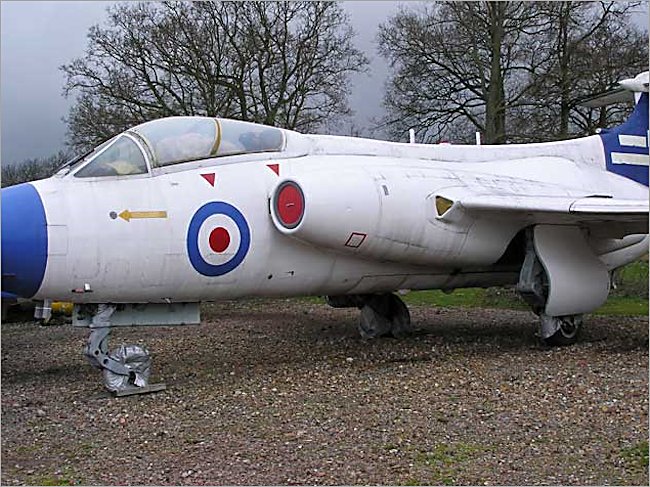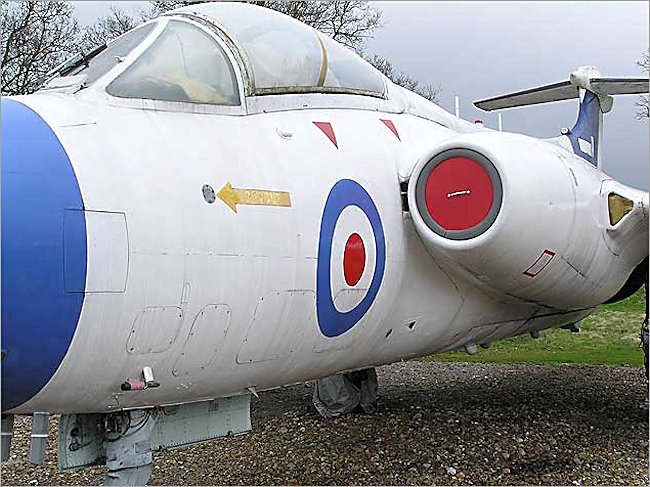Blackburn Buccaneer S.1
The RAF and Royal Navy Blackburn Buccaneer twin jet subsonic anti shipping and nuclear low level bomber first flew on the 30th of April 1958, with service trials being carried out on HMS Victorious from June 1959. it had a crew of two; pilot and observer. It was retired from RAF service at 1994. It had a maximum speed of 667 mph (580 kn, 1,074 km/h) at 200 ft (60 m) and a Range of 2,300 mi (2,000 nmi, 3,700 km). The Buccaneer had a service ceiling of 40,000 ft (12,200 m). It was powered by two Rolls-Royce Spey Mk 101 turbofans, 11,100 lbf (49 kN) each. The Blackburn Buccaneer had no guns. It had four under-wing pylon stations and a internal rotating bomb bay with a capacity of 12,000 lb (5,400 kg) and provisions to carry combinations of four Matra rocket pods with eighteen SNEB 68 mm rockets each or two It could carry various unguided bombs, Laser-guided bombs, as well as the Red Beard or WE.177 tactical nuclear bombs. Other equipment could also be attached like the AN/ALQ-101 ECM protection pod AN/AVQ-23 Pave Spike Laser designator pod, Buddy refuelling pack or Drop tanks for extended range and loitering time.
The Buccaneer S 1 was designed to achieve surprise by flying at subsonic speed under the enemy radar to deliver nuclear or conventional bombs against targets at sea or on land. The Buccaneer was designed to carry a substantial payload without the need to fly at airframe stressing supersonic speeds. It was fitted with avionics equipment that ensured precision navigation and weapons delivery accuracy. -9 Sidewinders for self-defence, 2x AS-30Ls or 2x AS-37 Martel missiles or 2x Sea Eagle missile.

Photograph taken at the Gatwick Aircraft Museum next to Gatwick Airport Sussex England
Some of the weapons payload is held in a rotating bomb bay, weapon delivery being by either conventional bombing or by "tossing" the bomb - a technique which added to the aircraft's survival chances, especially if delivering a nuclear weapon. During this time the majority of aircraft were painted a reflective white colour. The aircraft was also capable of photo reconnaissance and deep visual surface search. This role was employed during the 1965 Beira Patrol when the oil embargo on Rhodesia was being enforced.
The Blackburn Buccaneer XN923 at the Gatwick Aviation Museum did not see active service. It was used by the Ministry of Defence for service trials at West Freugh in Scotland and by A& AEE at Boscombe Down in Wiltshire. Purchased by Peter Vallance when put up for sale and transported to the Gatwick Aviation Museum in Charlwood by road arriving on 23rd March 1990.

Photograph taken at the Gatwick Aircraft Museum next to Gatwick Airport Sussex England
What is strange about the RAF Buccaneer Jet Cold War fighter is that the pilot and navigator sit side by side rather than one behind the other as in most fast jet fighter bomber designs. The Buccaneer was designed and initially produced by Blackburn Aircraft at Brough it was later known as the Hawker Siddeley Buccaneer when Blackburn became a part of the Hawker Siddeley group.
The Buccaneer jet was a British made low-level ground attack aircraft with the capacity to deliver a nuclear payload as well as conventional weapons. It served with the Royal Navy and the Royal Air Force between 1962 and 1994. It saw action in the 1991 Gulf War. The airframe, like the Sea Vixen, was built to handle the tough environment of Fleet Air Arm carrier operations.
In the early 1950's the Royal Navy wanted a specialized jet strike fighter that operated from fleet aircraft carriers that could sink the new Russian Navy Sverdlov class cruisers. They needed to be able to protect Britain's Merchant Marine ships. A jet fighter bomber would be a much cheaper option than building huge battle ships to take on the Russian Cruisers in open water.
The Blackburn Aircraft Limited aviation company won the tender with their design for a twin jet low level attack aircraft that had wings which could fold upwards to enable its use on an Aircraft carrier lift. It was designed by Barry P Laight. To cut down on drag the bomb bay doors were rotated inwards to open them and not outwards as on previous bombers.
The Buccaneer S.1 jets that were introduced in 1962 suffered from lack of power. The pair of de Havilland Gyron Junior turbojets producing 7,100 lbf (32 kN) of thrust were not up to the job. It could not take off it had a full fuel tank and a full load of weapons. To get over this serious problem the Buccaneer S.1s were launched with a half empty fuel tank. It was then refueled in midair before going on to its target.
The Buccaneer S.2 variant had an engine change and was fitted with two Rolls-Royce RB.168 Spey low-bypass turbofan jet engines. It was also used in the US F4 Phantom. This new engine had a lot more power at 21,000 lbf (94 kN) thrust. Finally the Buccaneer could take off fully loaded. The engine went on to earn an impressive safety record. It was the first jet engine to be allowed 10,000 hours between overhauls. This cut maintenance costs. It was one of the major reasons for the jet engine to continued in service even when newer designs were available. The Buccaneer S.2 variant had replaced all S.1 aircraft by the end of 1966.
Buccaneers entered service with the British Royal navy Fleet Air Arm (FAA) in 1962. To deal with the threat from Russian cruisers Fleet Air Arm. Six squadrons were equipped with Buccaneers armed with Red Beard and WE.177 drop-bombs. Buccaneers were later converted to carry Martel anti-ship missiles. They were given the designation Buccaneer S.2D. Later this was replaced with the Sea Eagle missile. The last Fleet Air Arm Buccaneer left the service in 1978 with the decommissioning of the aircraft carrier HMS Ark Royal.
Buccaneers entered service with the RAF quite late compared with the Fleet Air Arm. The started to be delivered to squadrons in 1969. Six squadrons were fitted out with these new air craft. Their primary roll in this Cold War era was to provide air support to NATO land forces facing the tanks and armies of the Warsaw Pact communist countries. They also had a nuclear capability. Luckily they were never used in either of these roles. Eventually they were replaced by the more advanced Tornado multirole aircraft that were starting to enter RAF service in 1983. Two squadrons were kept as anti shipping attack aircraft.
The Buccaneer's moment of glory happened in 1991 when the Buccaneer went to war. It flew 218 missions during the Gulf War. It was used to provide laser designation of targets for other aircraft dropping laser guided bombs. It was the only laser target marking aircraft then in service with the RAF. Buccaneers droped 48 laser-guided bombs themselves. The last Buccaneer Squadron was No. 208. When it disbanded in 1994 the Buccaneer was retired from RAF service.
For News and information on visiting the Gatwick Aviation Museum go to their website at www.gatwick-aviation-museum.co.uk